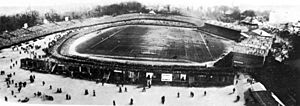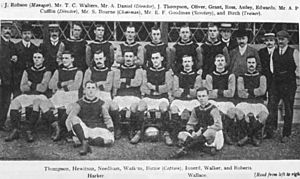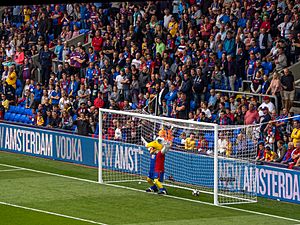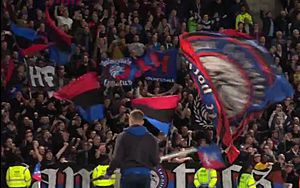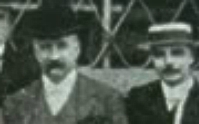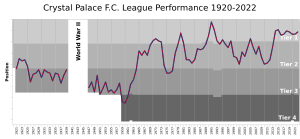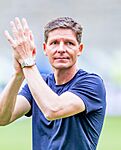Crystal Palace F.C. facts for kids
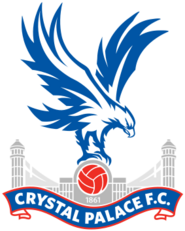 |
||
| Full name | Crystal Palace Football Club | |
|---|---|---|
| Nickname(s) |
|
|
| Short name |
|
|
| Founded | 10 September 1905 | |
| Stadium | Selhurst Park | |
| Stadium capacity |
25,486 | |
| Owners |
|
|
| Chairman | Steve Parish | |
| Manager | Oliver Glasner | |
| League | Premier League | |
| 2024–25 | Premier League, 12th of 20 | |
|
|
||
Crystal Palace Football Club, often called Crystal Palace or just Palace, is a professional football team from Selhurst, South London, England. They play in the Premier League, which is the top football league in England.
The club officially started as a professional team in 1905 at the Crystal Palace exhibition building. However, its roots go back to an amateur team formed in 1861. From 1905 to 1915, they played their home games at the FA Cup final stadium within the exhibition grounds. They had to leave in 1915 because of the First World War. In 1924, the club moved to its current home, Selhurst Park.
Crystal Palace spent their early years in the Southern League. They joined the Football League in 1920. For most of their history, they have played in the top two divisions of English football. Since 1964, Palace has only dropped below the second division once, for three seasons between 1974 and 1977. In the late 1980s and early 1990s, Palace had a very successful time in the top league. They reached the 1990 FA Cup final and finished third in the league in 1990–91. This is still the club's highest league finish ever.
The club was one of the founding members of the Premier League in 1992–93. They were relegated that season and also in 1994–95, 1997–98, and 2004–05. Palace returned to the Premier League in 2013 and have stayed there since. As of the 2025–26 season, they are playing their thirteenth straight season in the top league, a club record. They also reached two more FA Cup finals in 2016 and 2025. Winning the 2025 final gave the club its first major trophy in its history!
The club's kit colours were claret and blue until 1973. Then, they changed to the red and blue vertical stripes they wear today. Palace has a strong rivalry with Brighton & Hove Albion. This rivalry started in the 1970s because of tough competition between the teams. They also have rivalries with nearby Millwall and Charlton Athletic. These matches are known as South London derbies.
Contents
- Club History
- Early Days (1854–1905)
- Starting as a Professional Club (1905–1920)
- Joining the Football League (1920–1958)
- Promotions and Real Madrid (1958–1973)
- Ups and Downs (1973–1984)
- The Steve Coppell Era (1984–1993)
- The "Yo-Yo" Years (1993–1998)
- Financial Troubles and Recovery (1998–2013)
- Premier League Success and First Major Trophy (2013–Present)
- Team Colours and Crest
- Stadium
- Supporters
- Ownership
- Club Records and Statistics
- Players
- Notable Former Players
- Coaching Staff
- Managers
- Honours and Trophies
- European Record
- Crystal Palace Women's Team
- See also
Club History
Early Days (1854–1905)

In 1854, the famous Crystal Palace exhibition building was moved from Hyde Park, London to South London, near Sydenham Hill. The area around it was renamed Crystal Palace. It included Crystal Palace Park, where many sports facilities were built. The Crystal Palace Company, which owned the building, started a cricket club in 1857. A few years later, they formed an amateur Crystal Palace football club. Its first players were also part of the cricket team and shared the same pitch.
This amateur club helped create the Football Association in 1863. They played in the first ever FA Cup competition in 1871–72 and reached the semi-finals. They played in the FA Cup for four more seasons but then stopped appearing in records around 1875. In 1895, a new permanent place was found for the FA Cup final. It was at the sports stadium inside the exhibition grounds. Years later, the Crystal Palace Company wanted new attractions to bring in visitors. So, they decided to start a new professional football club to play at the stadium. They hoped this club would attract large crowds.
Starting as a Professional Club (1905–1920)
The professional Crystal Palace football club was formed on September 10, 1905. Edmund Goodman, who was an assistant at Aston Villa, helped set it up. The club wanted to join the Football League but was not accepted. Instead, they joined the Southern League Second Division for the 1905–06 season. Palace did very well in their first season, winning the league and getting promoted to the Southern League First Division. They also played in the mid-week United League, finishing second. Their very first match was in this league, a 3–0 away win against New Brompton.
Palace stayed in the Southern League until 1914. A big moment was their surprising 1–0 win over Newcastle United in the FA Cup in 1907. When the First World War began, the British Navy took over the Crystal Palace and its grounds. This forced the club to leave. They moved to Herne Hill Velodrome, the home of nearby West Norwood. Three years later, they moved again to the Nest after Croydon Common closed down.
Joining the Football League (1920–1958)
The club became a founding member of the new Football League Third Division in the 1920–21 season. They won the league that season and were promoted to the Second Division. This meant they were one of the few clubs at that time to win a championship in their first season in the league. Palace then moved to a new stadium, Selhurst Park, in 1924. They still play their home games there today.
The first game at Selhurst Park was against The Wednesday. Palace lost 0–1 in front of 25,000 fans. Finishing 21st, the club was relegated to the Third Division South. Before the Second World War, Palace tried hard to get promoted. They usually finished in the top half of the table and were runners-up three times. During the war, the Football League stopped, and the club won two wartime leagues. After the war, Palace was less successful in the league. Their highest position was seventh, and they had to ask to be re-elected to the league three times.
Promotions and Real Madrid (1958–1973)

The club stayed in the Third Division South until the end of the 1957–58 season. After that, the league was changed. Clubs in the bottom half of the Third Division South and North formed a new Fourth Division. Palace finished 14th, just below the cut-off, and ended up in the lowest division of English football. But they didn't stay there long.
Palace chairman Arthur Wait hired former Tottenham manager Arthur Rowe in April 1960. His exciting style of football was loved by Palace fans. In the 1960–61 season, Palace won promotion. They also had a special moment in 1962 when they played the famous Real Madrid team in a friendly match. This was the first time the Spanish giants had ever played in London. A full-strength Madrid team beat Palace 4–3. Even though Rowe left due to health reasons in late 1962, this promotion was a turning point for the club. Dick Graham and then Bert Head led Palace to back-to-back promotions in 1963–64 and 1968–69. This took the club through the Second Division and into the top league, the First Division.
Palace stayed in the top league from 1969 to 1973. They had some memorable results, like a great 5–0 home win against Manchester United in the 1972–73 season. Arthur Wait stepped down as chairman that season, and Raymond Bloye took over. Bloye hired Malcolm Allison as manager in March 1973. Unfortunately, the change came too late, and the club was relegated back to the Second Division.
Ups and Downs (1973–1984)
After being relegated from the top league, the next season was even worse. Under manager Malcolm Allison, Palace was relegated for a second time in a row, ending up in Division Three for the 1974–75 season. It was also under Allison that the club changed its nickname from "The Glaziers" to "The Eagles." They also stopped wearing claret and blue kit colours and switched to the red and blue vertical stripes they use today.
Palace had a good run to the semi-finals of the 1975–76 FA Cup. They beat Leeds and Chelsea along the way but lost 0–2 to Southampton in the semi-final. Allison left at the end of the 1975–76 season. Under Terry Venables' management, Palace moved back up to the top league with promotions in 1976–77 and 1978–79. In the latter season, they were crowned Division Two champions.
The 1979 team was called the "Team of the Eighties" because it had many talented young players from the youth team. This youth team had won the FA Youth Cup in 1976–77 and 1977–78. This team was even briefly at the top of the entire Football League in early 1979–80. However, the club faced money problems, and these players had to be sold. This led to Palace not being able to stay in the top league. Palace was relegated from the First Division in 1980–81. Ron Noades took over the club around this time. They struggled in the second division, and Noades even hired former Brighton manager Alan Mullery, which was very unpopular with Palace fans.
The Steve Coppell Era (1984–1993)
On June 4, 1984, Steve Coppell, a former Manchester United and England player, became Palace manager. He had recently retired due to injury. Coppell slowly rebuilt the club. The Eagles were promoted back to the First Division through the play-offs in 1988–89.
Palace then reached the 1990 FA Cup final, drawing 3–3 with Manchester United after extra-time in the first match. They lost the replay 0–1. The club built on this success, and the 1990–91 season saw Palace challenge Arsenal and Liverpool for the English league title. They finished in third place, their highest league finish ever. Palace missed out on a European place that season partly because of a ban on English clubs by UEFA. The club also returned to Wembley and won the Full Members Cup, beating Everton 4–1 in the final.
The next season, star striker Ian Wright left to join Arsenal. Palace finished tenth and became a founding member of the new Premier League in 1992–93.
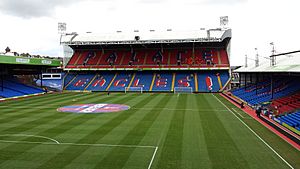
Palace then sold their other top striker, Mark Bright, to Sheffield Wednesday. They struggled to score goals that season and were relegated. They finished with 49 points, which is still a Premier League record for the most points for a relegated club. Coppell resigned, and his assistant, Alan Smith, took over as manager.
The "Yo-Yo" Years (1993–1998)
Alan Smith's first season as manager saw Palace win the First Division title and get promoted back to the Premier League. Their time in the Premier League was eventful. On January 25, 1995, Palace played Manchester United at Selhurst Park. United forward Eric Cantona was sent off. A Palace fan, Matthew Simmons, taunted him, and Cantona reacted with a flying kick. Simmons was banned from Selhurst Park. In March, Palace striker Chris Armstrong was suspended for failing a drug test. On the field, Smith led the club to the semi-finals of both the FA Cup and League Cup. However, their league form was not good, and Palace was relegated again. They finished fourth from bottom because the Premier League was reduced from 22 to 20 clubs.
Smith left, and Steve Coppell returned as technical director in 1995. With coaching from Ray Lewington and later Dave Bassett, Palace reached the play-offs. They lost the 1996 First Division play-off final in a dramatic way when Steve Claridge scored in the last minute of extra-time for Leicester City to win 2–1. The next season, Coppell became first-team manager when Bassett left. The club reached the play-offs again and this time won promotion back to the Premier League. They beat Sheffield United 1–0 in the final at Wembley.
The club's third time in the Premier League was not successful. Palace was relegated again at the end of the 1997–98 season. The club also got a new owner, Mark Goldberg, in June 1998.
Financial Troubles and Recovery (1998–2013)
Terry Venables returned to Palace as manager for a second time. The club even played in a European competition, the UEFA Intertoto Cup, in the summer. However, Palace went into administration in 1999 because owner Mark Goldberg could no longer support the club financially. Venables left, and Steve Coppell took over again as manager.
The club came out of administration under the ownership of Simon Jordan. Coppell was replaced by Alan Smith for a second time. Palace almost got relegated to the third division in Jordan's first season, 2000–01. Smith was fired in April, and long-serving coach Steve Kember became caretaker manager. He managed to win the last two games, which kept Palace in the league. Dougie Freedman scored the winning goal in the 87th minute on the final day, securing a 1–0 victory.
Former Manchester United captain Steve Bruce was appointed manager for the 2001–02 season. Palace started well, hoping for promotion. But Bruce tried to leave the club after only four months to become manager of Birmingham City. After a short break, Bruce was allowed to join Birmingham. Trevor Francis, who had been Bruce's predecessor at Birmingham, took over.
Under Francis, Palace finished in the middle of the table for two seasons. He was then fired and replaced by Steve Kember, who became the permanent manager. The club won their first three games of the 2003–04 season under Kember, putting them at the top of the table. But he was fired in November after the team's form dropped, and Palace slipped towards the relegation zone. Former Palace striker Iain Dowie was appointed manager. He led the club to the play-off final, winning promotion with a 1–0 victory over West Ham. Again, Palace could not stay in the top league and were relegated on the last day of the season after drawing with local rivals Charlton Athletic.
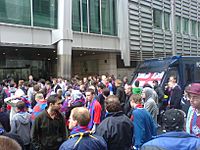
After that relegation, Simon Jordan struggled to keep the club financially stable. In January 2010, Palace was again placed in administration. Because of Football League rules, the club had ten points deducted. The administrators had to sell key players like Victor Moses and José Fonte. Neil Warnock had also left as manager earlier in 2010. Paul Hart took over as caretaker manager for the final weeks of the season. Staying in the Championship was only secured on the final day of the season after a memorable 2–2 draw at Sheffield Wednesday. Sheffield Wednesday was relegated as a result.
At the end of that season, CPFC 2010, a group of wealthy fans, successfully bought the club. They were led by Steve Parish. The group also bought back the freehold of Selhurst Park. This was helped by a fans' campaign that pressured Lloyds Bank to sell the ground back to the club.
The CPFC 2010 group quickly appointed George Burley as the new Palace manager. However, a poor start to the next season saw the club near the bottom of the table by December. On January 1, 2011, after a 0–3 loss to Millwall, Burley was fired. His assistant, Dougie Freedman, became caretaker manager. Just over a week later, Freedman was appointed full-time manager. Palace moved up the table and avoided relegation with a 1–1 draw at Hull City on April 30. After another year and a half, Freedman left to manage Bolton Wanderers in October 2012. The next month, Ian Holloway replaced him. Holloway led the club back to the Premier League after an eight-year absence. They beat Watford 1–0 in the Championship play-off final at the new Wembley Stadium.
Premier League Success and First Major Trophy (2013–Present)
Holloway resigned in October 2013. Tony Pulis then took over and guided the club away from relegation from the Premier League for the first time. He won the 2013–14 Premier League Manager of the Season award for this. However, he resigned two days before the start of the next season. After a short and unsuccessful second time for Neil Warnock, former Palace midfielder Alan Pardew became the new manager in January 2015. He led Palace to a tenth-place finish, their highest at that point in the Premier League.
In the 2015–16 season, Pardew led the club to the 2016 FA Cup final, their first in 26 years. They faced Manchester United again, losing 1–2 after extra-time. In December 2016, after a series of poor results, Pardew was fired and replaced by Sam Allardyce. Allardyce kept the club in the Premier League but unexpectedly resigned at the end of the 2016–17 season.
On June 26, 2017, Palace appointed Frank de Boer as their first permanent foreign manager. He was dismissed after only 77 days in charge. The club had lost their first four league games of the 2017–18 season and failed to score any goals. The next day, September 12, 2017, former England coach Roy Hodgson was appointed. He led the club to an eleventh-place finish that season, twelfth in 2018–19, and fourteenth in 2019–20. On May 18, 2021, the club announced Hodgson would leave at the end of the 2020–21 season.

On July 4, 2021, Palace appointed former Arsenal captain Patrick Vieira as their new manager. He signed a three-year contract. Despite leading the club to an FA Cup semi-final and a twelfth-place league finish in the 2021–22 season, Vieira was fired during the 2022–23 campaign on March 17, 2023. This happened after a 12-game winless streak left the club close to the relegation zone. On March 21, Hodgson was re-appointed Palace manager until the end of the season. He guided the club to safety, finishing comfortably in eleventh place. On July 3, he was appointed permanent manager for a second time. However, he stepped down midway through the 2023–24 season on February 19, 2024.
Hodgson was replaced by Austrian manager Oliver Glasner. Under Glasner, the club had a strong finish to the 2023–24 season. They won six of their last seven league games and equaled the club's highest Premier League finish of tenth place (achieved in 2015). After this, four Palace players (Eberechi Eze, Marc Guéhi, Dean Henderson and Adam Wharton) were chosen for the English national team for Euro 2024. This was more than any other club for England at the tournament.
In the 2024–25 season, Glasner led Palace to their first ever major trophy win! A goal from Eberechi Eze secured a 1–0 victory over Manchester City in the 2025 FA Cup final. This win also meant they qualified for the UEFA Europa League for the first time. However, their Europa League spot was soon at risk due to UEFA's rules about clubs having the same owner. Palace's main shareholder, John Textor, also owned French club Lyon, who had qualified for the same competition. On July 11, 2025, UEFA decided that Palace broke the rules on multi-club ownership. As a result, the club was moved down to the UEFA Conference League.
Team Colours and Crest
The original amateur club wore blue and white striped shirts with blue shorts. Their first kit in 1861 was likely light blue and white halves. When the professional Crystal Palace club started in 1905, their colours were claret and blue shirts with white shorts and claret socks. This was because Edmund Goodman, an Aston Villa employee who later became Palace manager, played a big part in forming the club. Aston Villa's colours were claret and blue.
Palace mostly kept these colours until 1938. Then, they changed to white shirts and black shorts. They went back to claret and blue from 1949 to 1954. In 1955, they returned to white and black, but with claret and blue trim.
There were more changes until 1963, when the club started using their yellow away shirts as their home colours. In 1964, they switched to an all-white kit, like Real Madrid, whom Palace had recently played. They returned to claret and blue shirts with white shorts in 1966. The club continued with these colours until Malcolm Allison became manager in 1973. Allison completely changed the club's look. He chose red and blue vertical stripes for the kit, inspired by Barcelona. Palace has played in different versions of red and blue ever since. The only exception was the 2005 centenary season, when they wore a version of their 1971–72 claret, blue, and white kit.
The club was quite late in getting a crest (badge). Although the club's initials were on the shirt from the 1935–36 season, a crest showing the front of The Crystal Palace building didn't appear until 1955. This crest disappeared from the shirt in 1964. The team's name was embroidered on shirts between 1967 and 1972. A round badge was then used in 1972, with the club's initials and nickname "Glaziers." Allison changed this too. The club's nickname became the "Eagles," inspired by Portuguese club Benfica. The new badge showed an eagle holding a ball. This emblem stayed until 1987, when the club combined the eagle with the Crystal Palace building. This crest was updated in 1996 and again in 2012, but it still has these features. In June 2022, the club changed the year on its crest from 1905 to 1861. This shows when the original Crystal Palace Football Club was formed.
From mid-2010 to 2020, the club used an American bald eagle named Kayla as their mascot. The bird would fly from one end of the stadium to the other at every home game. Kayla passed away in June 2020.
Kit Makers and Sponsors
Since 2022, Crystal Palace's kit has been made by Macron. Before that, other companies like Umbro, Adidas, and Nike made their kits.
The club's shirts are currently sponsored by NET88 (since 2024). Many other companies have sponsored their shirts in the past, including Virgin Atlantic and TDK. In 2017, the club got its first sleeve sponsor, All Football. In 2023, Crystal Palace and Kaiyun Sports announced a partnership for Kaiyun Sports to become the club's official new sleeve sponsor.
Stadium
In 1905, the Crystal Palace Company wanted a professional club to play at the FA Cup final venue. They formed the new professional Crystal Palace F.C. to play there. When the First World War started, the military took over the Palace and its grounds. In 1915, the club was forced to leave. They found a temporary home at the Herne Hill Velodrome. The club wanted to stay close to their local area. When Croydon Common closed in 1917, Palace took over their old stadium, the Nest. In 1919, they started buying the land where they would build Selhurst Park, their current home.
The famous stadium architect Archibald Leitch designed the plans. Selhurst Park was finished in time for the 1924–25 season. The stadium stayed mostly the same, with only floodlights added and some repairs, until 1969, when the Arthur Wait Stand was built. The Main Stand became all-seater in 1981. More work followed when the Whitehorse Lane End was redeveloped for a Sainsbury's supermarket, club offices, and a club shop. The Arthur Wait Stand became all-seater in 1990. In 1994, the Holmesdale Terrace was replaced with a new two-tier stand.
Selhurst Park's record attendance was in 1979, with 51,482 fans. After all the changes and safety rules, the current capacity is 25,486.
In 2011, there were ideas to move the club back to their original home at the Crystal Palace National Stadium. But after the club was promoted to the Premier League in 2013, the focus shifted to making Selhurst Park a 40,000-seat stadium. Revised plans for a new 13,500-seat Main Stand (making the total capacity 34,000) were approved in April 2018. These plans were delayed by the Covid-19 pandemic and the club's focus on upgrading its Academy. When the club pushed for the stand redevelopment again, there were more delays due to opposition from people living in nearby Wooderson Close. The club signed a legal agreement to provide new homes for these residents. In August 2024, the Main Stand expansion was approved again, and work began. It is expected to be finished by summer 2027.
Supporters
Crystal Palace has many fans mainly from the local areas of South London, Kent, and Surrey. Their original home was near the border with Kent, and Selhurst Park was in Surrey until Greater London was formed in 1963. The club's passionate support at home games comes from the Holmesdale Road Stand. This is where the ultras group, known as the Holmesdale Fanatics, have been since 2005.
Fans have also created other supporter groups. The Palace Independent Supporters' Association was set up to share fan concerns with the club. The Crystal Palace Supporters' Trust was formed to help fans buy the club when it was in administration in 2000.
Fans have also made several fanzines (fan magazines) over the years. Eagle Eye started in 1987. Palace Echo took its place in 1995. Five Year Plan is another fanzine that now has an online presence. Fans also discuss the club on two internet forums, The BBS and Holmesdale.net. The club uses these forums to talk with fans.
Because Crystal Palace is a London club, they compete with other local clubs for fans. However, they have a large fan base of 900,000 people. In 2010, the new group of owners led by Steve Parish asked fans for their ideas on future decisions. A few years later, they asked for ideas for a new badge design. When their own designs were not popular, the club chose a design based on a fan's idea from an internet forum.
The club has also made its connections with the local community stronger. Through the Crystal Palace F.C. Foundation, they work with local areas like Croydon, Bromley, and Sutton. They provide sports and educational programs, hoping to grow their fan base. The Football League recognized the Foundation's work in August 2009.
Many famous people also support the club. Comedians Kevin Day, Jo Brand, Eddie Izzard, and Mark Steel are big Palace fans. Actor Neil Morrissey helped create Palace Ale, a beer sold at the stadium. Actor Bill Nighy supports the Crystal Palace Children's Charity. Radio DJ David Jensen is chairman of the Crystal Palace Vice Presidents Club. Actor John Salthouse played for Palace as a young man. TV presenter Susanna Reid is a fan. Bill Wyman, the bass player from the Rolling Stones, is a lifelong fan. British Olympic gold medalist Alex Yee also supports the club.
Rivalries
Crystal Palace has several local rivalries because it is a London club. They have rivalries with Millwall and former tenants Charlton Athletic. They also have a long and strong rivalry with Brighton & Hove Albion. This rivalry grew after Palace was relegated in 1974. It became very intense when the two teams played in the FA Cup in 1976–77. The match went to two replays. The second replay ended in controversy when the referee ordered a successful Brighton penalty to be retaken. Palace won the game 1–0, and a fierce rivalry was born.
Ownership
The Crystal Palace Company started both the amateur and professional clubs. The first chairman of the professional Crystal Palace club was Sydney Bourne. Club secretary Edmund Goodman found him by looking at records of FA Cup final ticket buyers. Goodman noticed Bourne bought many tickets every year. He met Bourne, who liked the idea of the new club. Bourne joined the board of directors and was chosen as chairman at the club's first meeting. He remained chairman until he passed away in 1930.
After Bourne, there were several chairmen for shorter periods. In 1949, local builder Arthur Wait formed a group of eight businessmen to buy the club. Wait took over from Percy Harper in 1950. In 1958, Wait became the permanent chairman and stayed until 1972. Raymond Bloye then took over until January 26, 1981, when property developer Ron Noades and his group took control. Noades eventually sold the club to Mark Goldberg in June 1998. However, Noades kept ownership of Selhurst Park and leased it to the club. Goldberg's time as owner was not successful, and Palace went into administration in March 1999. Although fans tried to gain control, millionaire and lifelong fan Simon Jordan made a deal, and a new company, CPFC 2000, took control. This company went into administration in January 2010. It was not until June of that year that a group of four wealthy fans, known as CPFC 2010, completed a takeover.
CPFC 2010 was formed by four businessmen: Steve Parish, Martin Long, Stephen Browett, and Jeremy Hosking. Each owned a 25% share. They successfully negotiated the takeover. The group also bought back Selhurst Park from Lloyds Bank after fans protested and pressured the bank to agree.
In December 2015, American investors Josh Harris and David Blitzer each bought an 18% share in the club for £50 million. Their share is now estimated to be 10%. In August 2021, another American investor, John Textor, bought a 40% share worth £87.5 million, which increased to 45% in 2023. Parish remains chairman with 10% ownership. Robert Franco and other investors own the rest. In June 2025, Textor agreed to sell his share in the club to Woody Johnson, who owns the NFL's New York Jets.
Club Records and Statistics
Jim Cannon holds the record for the most Crystal Palace appearances. He played 660 first-team matches between 1973 and 1988. He also holds the record for most league appearances, with 571. Striker Peter Simpson holds the record for most goals scored in a season, with 54 goals in the 1930–31 season. He is also the club's all-time top scorer, with 165 goals between 1929 and 1935. Goalkeeper Wayne Hennessey has the club record for most international appearances for his country.
Crystal Palace were the first champions of the new Third Division in 1920–21. This was also their first season in the Football League. So, they became one of the few clubs to win a Football League Division in their very first try. Their average league attendance of 19,092 in the 1960–61 season and the attendance of 37,774 for the Good Friday game against Millwall that same season are Fourth Division attendance records. Palace's official record home attendance is 51,482 for a Second Division match against Burnley on May 11, 1979. The club's biggest league win was 9–0 at home against Barrow in 1959. Their heaviest league defeat was by the same score, 9–0 away to Liverpool in 1989.
The highest transfer fee received for a Crystal Palace player is £50.8 million from Bayern Munich for Michael Olise in July 2024. The highest transfer fee paid by the club is £32 million for Christian Benteke from Liverpool in August 2016.
The club's highest ever league finish is third place in the old Football League First Division (now the Premier League). This happened in the 1990–91 season. Palace holds the record for the most points for a relegated Premier League club, with 49 points (though this was in a 42-game season in 1992–93). They are also the only club to be relegated from the Premier League even though they finished fourth from bottom. This happened at the end of the 1994–95 season when the league was reduced from 22 to 20 clubs. Palace's 45 points that season is the second-highest for a relegated club. Palace holds the record for the most play-off final wins (4) that resulted in promotion to the top league. Each of these wins happened at a different location: Selhurst Park in 1989, old Wembley Stadium in 1997, Millennium Stadium in Cardiff in 2004, and new Wembley in 2013.
Players
First-team Squad
|
|
Players on Loan
These are players who are usually part of the first team or under-21 players who have played for the first team or been called up for a game.
|
|
Youth Academy
Notable Former Players
- You can find players with over 100 appearances for Crystal Palace here.
- All past (and present) players who have Wikipedia articles can be found here.
Crystal Palace "Centenary XI"
To celebrate Crystal Palace's 100th birthday in 2005, fans voted for a "Centenary XI" (best team of 11 players). Here are the players chosen:
 Nigel Martyn (1989–96)
Nigel Martyn (1989–96) Paul Hinshelwood (1974–83)
Paul Hinshelwood (1974–83) Chris Coleman (1991–95)
Chris Coleman (1991–95) Jim Cannon (1972–88)
Jim Cannon (1972–88) Kenny Sansom (1975–80)
Kenny Sansom (1975–80) John Salako (1986–95)
John Salako (1986–95) Geoff Thomas (1987–93)
Geoff Thomas (1987–93) Andy Gray (1984–87, 1989–92)
Andy Gray (1984–87, 1989–92) Attilio Lombardo (1997–99)
Attilio Lombardo (1997–99) Andrew Johnson (2002–06, 2014)
Andrew Johnson (2002–06, 2014) Ian Wright (1985–91)
Ian Wright (1985–91)
Coaching Staff
| Position | Name |
|---|---|
| Sporting director | Vacant |
| Manager | Oliver Glasner |
| Assistant manager | Ronald Brunmayr |
| First-team coach | Paddy McCarthy Emanuel Pogatetz Michael Angerschmid |
| Goalkeeping coach | Dean Kiely |
| Fitness coach | Michael Berktold |
| Academy director | Gary Issott |
| Under-21s manager | Darren Powell |
| Head of sports medicine | Imtiaz Ahmad |
Managers
- These statistics are up to May 25, 2025. They do not include caretaker managers and count all competitive matches.
-
Oliver Glasner, the club's current manager since February 2024, who won the 2024–25 FA Cup with Palace.
| Name | From | To | G | W | D | L | %W |
|---|---|---|---|---|---|---|---|
| Jack Robson | July 1905 | 30 April 1907 | 77 | 35 | 18 | 24 | 45.45 |
| Edmund Goodman | 1 May 1907 | 24 November 1925 | 613 | 242 | 166 | 205 | 39.48 |
| Alex Maley | 24 November 1925 | 12 October 1927 | 83 | 36 | 16 | 31 | 43.37 |
| Fred Mavin | 21 November 1927 | 18 October 1930 | 132 | 63 | 33 | 36 | 47.73 |
| Jack Tresadern | 27 October 1930 | June 1935 | 213 | 98 | 44 | 71 | 46.01 |
| Tom Bromilow | July 1935 1 January 1937 |
July 1936 July 1939 |
162 | 71 | 40 | 51 | 43.83 |
| R. S. Moyes | July 1936 | 8 December 1936 | 23 | 6 | 6 | 11 | 26.09 |
| George Irwin | July 1939 | July 1947 | 45 | 15 | 11 | 19 | 33.33 |
| Jack Butler | July 1947 | June 1949 | 88 | 23 | 24 | 41 | 26.14 |
| Ronnie Rooke | June 1949 | 29 November 1950 | 62 | 19 | 15 | 28 | 30.65 |
| Fred Dawes/Charlie Slade | 29 November 1950 | 11 October 1951 | 40 | 8 | 10 | 22 | 20.00 |
| Laurie Scott | 11 October 1951 | October 1954 | 145 | 43 | 41 | 61 | 29.66 |
| Cyril Spiers | October 1954 | June 1958 | 181 | 52 | 53 | 76 | 28.73 |
| George Smith | July 1958 | 12 April 1960 | 100 | 42 | 27 | 31 | 42.00 |
| Arthur Rowe | 15 April 1960 | 30 November 1962 | 132 | 52 | 32 | 48 | 39.39 |
| Dick Graham | 30 November 1962 | 3 January 1966 | 150 | 68 | 41 | 41 | 45.33 |
| Bert Head | 18 April 1966 | 30 March 1973 | 328 | 101 | 96 | 131 | 30.79 |
| Malcolm Allison | 30 March 1973 1 December 1980 |
May 1976 26 January 1981 |
155 | 53 | 48 | 54 | 34.19 |
| Terry Venables | 1 June 1976 9 June 1998 |
14 October 1980 15 January 1999 |
220 | 80 | 76 | 64 | 36.36 |
| Dario Gradi | 26 January 1981 | 10 November 1981 | 30 | 7 | 3 | 20 | 23.33 |
| Steve Kember | 10 November 1981 18 April 2003 |
June 1982 3 November 2003 |
53 | 15 | 14 | 24 | 28.30 |
| Alan Mullery | July 1982 | June 1984 | 98 | 31 | 27 | 40 | 31.63 |
| Steve Coppell | July 1984 July 1995 28 February 1997 15 January 1999 |
21 May 1993 8 February 1996 13 March 1998 1 August 2000 |
565 | 221 | 146 | 198 | 39.12 |
| Alan Smith | 3 June 1993 1 August 2000 |
15 May 1995 29 April 2001 |
163 | 62 | 43 | 58 | 38.04 |
| Dave Bassett | 8 February 1996 | 27 February 1997 | 60 | 29 | 15 | 16 | 48.33 |
| Attilio Lombardo | 13 March 1998 | 29 April 1998 | 7 | 2 | 0 | 5 | 28.57 |
| Steve Bruce | 30 May 2001 | 31 October 2001 | 18 | 11 | 2 | 5 | 61.11 |
| Trevor Francis | 30 November 2001 | 18 April 2003 | 78 | 28 | 22 | 28 | 35.90 |
| Iain Dowie | 22 December 2003 | 22 May 2006 | 123 | 50 | 29 | 44 | 40.65 |
| Peter Taylor | 13 June 2006 | 8 October 2007 | 60 | 21 | 16 | 23 | 35.00 |
| Neil Warnock | 11 October 2007 27 August 2014 |
2 March 2010 27 December 2014 |
146 | 50 | 45 | 51 | 34.25 |
| Paul Hart | 2 March 2010 | 3 May 2010 | 14 | 3 | 6 | 5 | 21.43 |
| George Burley | 17 June 2010 | 1 January 2011 | 25 | 7 | 5 | 13 | 28.00 |
| Dougie Freedman | 11 January 2011 | 23 October 2012 | 90 | 32 | 27 | 31 | 35.56 |
| Ian Holloway | 3 November 2012 | 23 October 2013 | 46 | 14 | 14 | 18 | 30.43 |
| Tony Pulis | 23 November 2013 | 14 August 2014 | 28 | 12 | 5 | 11 | 42.86 |
| Alan Pardew | 2 January 2015 | 22 December 2016 | 87 | 35 | 13 | 39 | 40.23 |
| Sam Allardyce | 23 December 2016 | 23 May 2017 | 24 | 9 | 3 | 12 | 37.50 |
| Frank de Boer | 26 June 2017 | 11 September 2017 | 5 | 1 | 0 | 4 | 20.00 |
| Roy Hodgson | 12 September 2017 21 March 2023 |
23 May 2021 19 February 2024 |
200 | 66 | 47 | 87 | 33.00 |
| Patrick Vieira | 4 July 2021 | 17 March 2023 | 74 | 22 | 25 | 27 | 29.73 |
| 19 February 2024 | present | 61 | 29 | 17 | 15 | 47.54 |
Honours and Trophies
Leagues
- Second Division / First Division / Championship (level 2)
- Champions: 1978–79, 1993–94
- Runners-up: 1968–69
- Play-off winners: 1989, 1997, 2004, 2013
- Third Division South / Third Division (level 3)
- Champions: 1920–21
- Runners-up: 1928–29, 1930–31, 1938–39, 1963–64
- Fourth Division (level 4)
- Runners-up: 1960–61
Cups
- FA Cup
- Winners: 2024–25
- Runners-up: 1989–90, 2015–16
- Full Members Cup
- Winners: 1990–91
Wartime Titles
- Football League South
- Champions: 1940–41
- Wartime South D League
- Champions: 1939–40
European Record
| Season | Competition | Round | Opponent | Home | Away | Aggregate |
|---|---|---|---|---|---|---|
| 1998–99 | UEFA Intertoto Cup | Round 3 | 0–2 | 0–2 | 0–4 | |
| 2025–26 | UEFA Conference League | Play-off Round |
Crystal Palace Women's Team
Crystal Palace Women is a women's football club that started in 1992. It is connected to the men's team. They currently play in the Women's Super League 2. Their home games are at the VBS Community Stadium in Sutton, South London.
See also
 In Spanish: Crystal Palace Football Club para niños
In Spanish: Crystal Palace Football Club para niños
- Football in London


